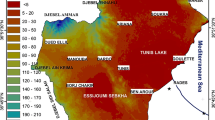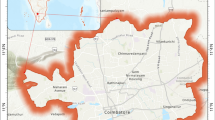Abstract
Adoption of most suitable post mining land use is a problem with multi-dimensional nature. There are so many factors in this problem which seriously influence on the decision judgments. Therefore, in this study a fifty-attribute framework for mined land suitability analysis including fifty numbers of economical, social, technical and mine site factors developed to be a foundation for this decision making problem. Analysis by an outranking multi-attribute decision-making technique, called elimination et choix traduisant la realite method, was taken into consideration because of its clear advantages on the field of mined land suitability analysis as compared with multi-attribute decision-making ranking techniques. Analytical hierarchy process method applied to calculate global weights of the attributes through pair wise comparison matrixes. The weights then passed to the elimination et choix traduisant la realit method so that the most efficient post mining land uses could be appointed through comparisons of pair-wise dominance relationships between alternatives. This approach applied to an illustrative example where, final results showed that, there were two non-dominated land-uses for the considered example; industrial and pasture. However by increasing indifference threshold limit, the non-dominated set reduced to a single alternative that was pasture land-use.
Similar content being viewed by others
References
Alexander, M. J., (1998). The effectiveness of small-scale irrigated agriculture in the reclamation of mine land soils on the Jos Plateau of Nigeria, Land Degrad. Dev., 7(1), 77–85.
Bascetin, A., (2007). A decision support system using analytical hierarchy process for the optimal environmental reclamation of an open-pit mine, Environ. Geol., 52(4), 663–672.
Benayoun, R.; Roy, B.; Sussman B., (1966). ELECTRE: Une méthode pour guider le choix en présence de points de vue multiples, Note de travail 49, SEMA-METRA International Direction Scientifique.
Cairns, J., (1972). Ecological considerations in reclaiming surface mined lands, Miner. Environ., 1(3), 83–89
Cao, X., (2007). Regulating mine land reclamation in developing countries: The case of China, Land Use Policy, 24(2), 472–483.
Carrick, P. J.; Kruger, R., (2007). Restoring degraded landscapes in lowland Namaqualand: Lessons from the mining experience and from regional ecological dynamics, J. Arid Environ., 70(4), 767–781.
Chen, H.; Zheng, C.; Zhu, Y., (1999). Phosphorus: A limiting factor for restoration of soil fertility in a newly reclaimed coal mined site in Xuzhou, China, Land Degrad. Dev., 9(2), 115–121.
Coppin, N. J.; Bradshaw, A. D., (1982). Quarry reclamation; The establishment of vegetation in quarries and open pit non-metal mines, Mining Journal Books Ltd., London, England, 18–25.
Eddie, W. L.; Heng, L.; Danny, C. K., (2002). Analytical hierarchy process (AHP); A defective tool when used improperly, Meas. Bus. Excellence, 6(4), 33–37.
Errington, J. C., (2001). Mine reclamation in British Columbia, 25 years of progress, 25th. Annual British Columbia Mine Reclamation Symposium, Campbell River, BC.
Gizikoff, K. G., (2004). Re-establishing livestock use on mined landscapes in the southern interior of BC, Available online: www.trcr.bc.ca/docs/2004-gizikoff.pdf.
Hill, C., (2003). Deloro mine site cleanup young’s creek mine area rehabilitation alternatives final report, prepared for Ontario Ministry of the Environment, 107.
Hindle, J. P.; Grosskopf, T., (2000). Agricultural land classification study — Taree shire, report on methodology to accompany agricultural land classification map for Taree Shire, 17.
Hong, I. B.; Vogel, D. R., (1991). Data and model management in a genera1ized MCDM-DSS, Decision Sci., 22(1), 1–25
Howat, D. R., (2000). Acceptable salinity, sodicity and pH values for Boreal forest reclamation, Alberta Environment, Environmental Sciences Division, Edmonton Alberta, ISBN 0-7785-1174-X (on-line edition), 191.
Joerin, F.; Theriault, M.; Musy, A., (2001). Using GIS and outranking multicriteria analysis for land use suitability assessment, Int. J. Geogr. Inf. Sci., 15(2), 153–174
Messing, I.; Hoang, M. H., (2001). Using farmers’ knowledge for defining criteria for land qualities in biophysical land evaluation, Land Degrad. Dev., 12(6), 541–553
Mu, Y., (2006). Developing a suitability index for residential land use: A case study in Dianchi drainage area. MS.c. thesis in Environmental Studies in Geography, Waterloo, Ontario, Canada.
Nijkamp, P., (1977). Stochastic quantitative and qualitative multicreteria analysis for environmental design, Pap. Reg. Sci. Assoc., 39(1), 175–199.
Osanloo, M.; Akbari, A. D.; Hamidian, H., (2006). Selecting post mining land use through analytical hierarchy processing method: case study in Sungun copper open pit mine of Iran, 15th. International symposium of MPES, Torino, Italy.
Osanloo, M.; Hekmat, A.; Aghajani Bazazi, A., (2006). Reclamation of granite stone quarry — A case study in Jostan granite mine, Tehran, Iran, 1st. international seminar on mine closure, Perth, Australia
Paschke, M. W.; Redente, E. F.; Brown, S. L., (2003). Biology and establishment of mountain shrubs on mining disturbances in the Rocky mountains, Usa, Land Degrad. Dev., 14(5), 459–480.
Roy, B., (1968). Classement et choix en présence de points de vue multiples (la méthode ELECTRE), RIRO, 8, 57–75.
Roy, B.; Skalka, J., (1984). ELECTRE IS: Aspects méthodologiques et guide d’utilisation, Document du LAMSADE,30, Université Paris Dauphine
Saaty, L. T., (1980). The analytical hierarchy process: Planning, priority setting. Resource allocation, McGraw Hill Company, New York.
Saaty, L. T., (1990). The analytical hierarchy process, McGraw Hill, New York.
Soltanmohammadi, H.; Osanloo, M.; Aghajani, A., (2008). Developing a fifty-attribute framework for mined land suitability analysis using AHP-TOPSIS approach, post mining symposium, Nancy, France
Stellin, J. R.; Hennies, A.; Soares, L.; Fujimura, F.; Lauand, V., (2005). Area recovery project of dimension stone quarry mine, COMI and MPES, Banff, Alberta, Canada. 951–965.
Tafi, T. C.; Neuman, D.; Wraith, J.; Fedock, J., (2006). Reclamation effectiveness at three reclaimed abandoned mine sites in Jefferson County, Montana, Land Rehabilitation, Montana State University, Bozeman, Montana.
Uberman R.; Ostrêga, A., (2005). Applying the analytical hierarchy process in the revitalization of post mining regions, ISAHP 2005, Honolulu, Hawaii.
Author information
Authors and Affiliations
Corresponding author
Rights and permissions
About this article
Cite this article
Soltanmohammadi, H., Osanloo, M., Rezaei, B. et al. Achieving to some outranking relationships between post mining land uses through mined land suitability analysis. Int. J. Environ. Sci. Technol. 5, 535–546 (2008). https://doi.org/10.1007/BF03326051
Received:
Revised:
Accepted:
Published:
Issue Date:
DOI: https://doi.org/10.1007/BF03326051




